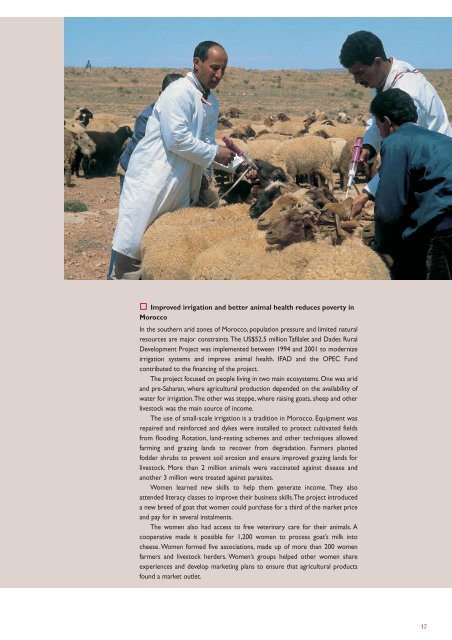A partnership to eradicate rural poverty - IFAD
A partnership to eradicate rural poverty - IFAD
A partnership to eradicate rural poverty - IFAD
You also want an ePaper? Increase the reach of your titles
YUMPU automatically turns print PDFs into web optimized ePapers that Google loves.
Improved irrigation and better animal health reduces <strong>poverty</strong> in<br />
Morocco<br />
In the southern arid zones of Morocco, population pressure and limited natural<br />
resources are major constraints.The US$52.5 million Tafilalet and Dades Rural<br />
Development Project was implemented between 1994 and 2001 <strong>to</strong> modernize<br />
irrigation systems and improve animal health. <strong>IFAD</strong> and the OPEC Fund<br />
contributed <strong>to</strong> the financing of the project.<br />
The project focused on people living in two main ecosystems. One was arid<br />
and pre-Saharan, where agricultural production depended on the availability of<br />
water for irrigation.The other was steppe, where raising goats, sheep and other<br />
lives<strong>to</strong>ck was the main source of income.<br />
The use of small-scale irrigation is a tradition in Morocco. Equipment was<br />
repaired and reinforced and dykes were installed <strong>to</strong> protect cultivated fields<br />
from flooding. Rotation, land-resting schemes and other techniques allowed<br />
farming and grazing lands <strong>to</strong> recover from degradation. Farmers planted<br />
fodder shrubs <strong>to</strong> prevent soil erosion and ensure improved grazing lands for<br />
lives<strong>to</strong>ck. More than 2 million animals were vaccinated against disease and<br />
another 3 million were treated against parasites.<br />
Women learned new skills <strong>to</strong> help them generate income. They also<br />
attended literacy classes <strong>to</strong> improve their business skills.The project introduced<br />
a new breed of goat that women could purchase for a third of the market price<br />
and pay for in several instalments.<br />
The women also had access <strong>to</strong> free veterinary care for their animals. A<br />
cooperative made it possible for 1,200 women <strong>to</strong> process goat’s milk in<strong>to</strong><br />
cheese. Women formed five associations, made up of more than 200 women<br />
farmers and lives<strong>to</strong>ck herders. Women’s groups helped other women share<br />
experiences and develop marketing plans <strong>to</strong> ensure that agricultural products<br />
found a market outlet.<br />
17

















